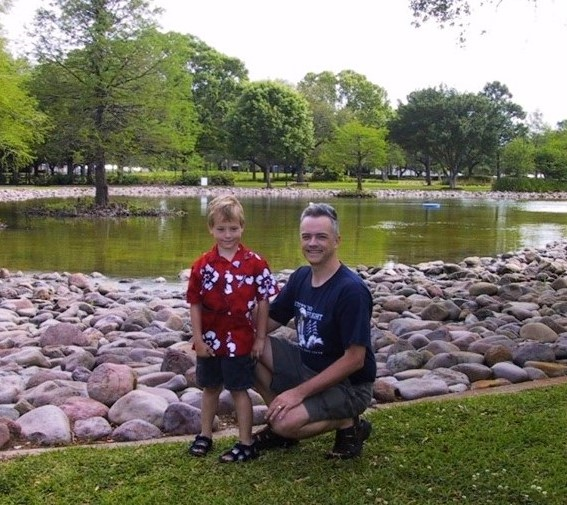Q&A with Gateway: Meet Timothy ‘Tim’ Thornton, Reliability and Maintainability Lead for the Safety & Mission Assurance Office
The Gateway, a multipurpose outpost orbiting the Moon and a vital part of NASA’s Artemis program, is built with sound engineering and operational principles that will serve as a staging point for deep space exploration and model for future missions to Mars. As Reliability and Maintainability (R&M) lead for the Safety and Mission Assurance Office for the Gateway program, NASA Johnson Space Center-based Tim Thornton is responsible for maintaining oversight of R&M, reviewing the Gateway program requirements and specification document to ensure these needs are implemented; supporting development of program maintenance concepts; and reviewing, coordinating, and approving the Failure Modes and Effects Analysis and Critical Items List.
Keep reading to learn more about Tim Thornton, below!
What does your office do for the Gateway program?
The Reliability and Maintainability Office is responsible for ensuring the design solutions meet the established R&M requirements and elevating any discrepancies to appropriate decision makers.
What are you most excited to share about Gateway and what it will do for human exploration as part of the Artemis program?
Sustaining life, operations, and systems away from low-Earth orbit must be demonstrated, and it must be done safely and reliably. The Gateway is the best spacecraft for that demonstration. Through Gateway, exploration will become more routine as methods are developed and tested.
How has your personal background influenced your work in the Gateway program?
Observation and experience of failures, successes, and recoveries learned from the Space Shuttle, International Space Station, and Commercial Crew programs, along with my experience in the oil and gas industry, have shaped my career and continue to influence my work on the Gateway.
What has been your favorite memory while working at NASA?
The picture below, taken in 1966, shows my dad and me by the pond in front of Building 1 at Johnson. Little did I know that, 40 years later, I would be working at Johnson and be in the same spot with my son. I’ve made a lot of great memories, including when I received my Silver Snoopy Award, but this one is probably at the top.
Being surrounded by such a high-performing group of people, what’s a great piece of advice you’ve learned?
Speak up and don't be intimidated or assume that people know what you do or can see from your perspective.
In line with JSC’s DARE | UNITE | EXPLORE, how do you see yourself fitting into the vision?
Certainly, the “sweet spot” is where these three intersect. We can't keep doing the same things and expect different results. I believe innovation can be achieved by embracing this vision and not compromising on R&M, but looking for new ways to accomplish it.
More about you:
Where did you grow up?
I grew up in southwest Houston.
If you could temporarily live (or visit) in another part of the world, where would that be?
I have traveled to quite a few places around the world, including Canada, the United Kingdom, Holland, France, Norway, and Brazil, but I prefer to be in my own backyard.
How long have you been at JSC?
I started my first job out of college in 1986 as a reliability engineer for the Space Shuttle program. I started right after the Challenger accident, and I was involved in the redesign efforts to get crew flying again. I was at Johnson until 2012, when I transferred to the oil and gas industry. However, I returned in 2018 — since there’s no place like home!
Describe yourself in five words:
Discerning, inquisitive, calm, encouraging, and funny.
Favorite thing(s) to do to unwind:
I enjoy watching car or home repair videos on YouTube, watching westerns or war movies, woodworking, or tinkering on my 1969 Corvette.
How has the pandemic shaped your work style?
I don't think my work style has changed much. I now must remind myself to get up and move around so that I’m not always working. I also have had to adjust my “workspace” at home.
Name one thing we would be surprised to learn about you.
I made the front page of the Houston Chronicle. The article was called, "From orbit to drill bit, NASA exes bring deep understanding of risk." A reporter interviewed me regarding my effort to help transform a major oil and gas equipment provider using my experience from NASA.
 Left image: Tim Thornton, when he was little, with his dad. Right image: Tim Thornton replicates the moment with his son. Images courtesy of Tim Thornton.
Left image: Tim Thornton, when he was little, with his dad. Right image: Tim Thornton replicates the moment with his son. Images courtesy of Tim Thornton.
At Johnson, we are laser-focused on the next: going forward to our lunar neighbor to build outposts in uncharted territory while revolutionizing the strategies and technologies that will eventually open up the universe. The Gateway is a critical component of the Artemis program and embodies Johnson's DARE | UNITE | EXPLORE vision: We dare to expand frontiers. We unite with our partners to complete bold missions. We explore space to benefit humanity.
DARE | UNITE | EXPLORE








